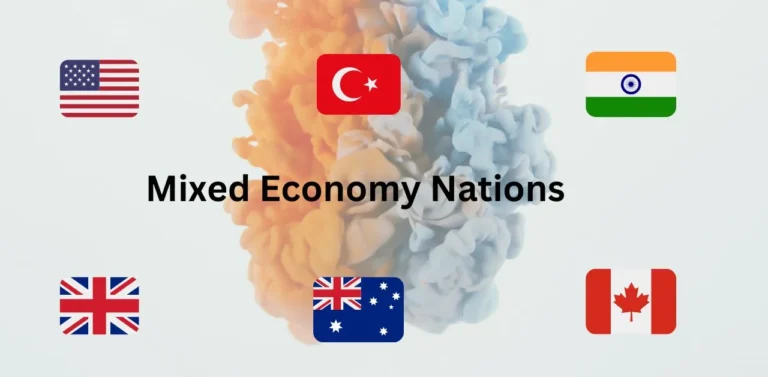In the vast arena of global economics, various countries adopt distinct strategies to manage their financial systems. One prominent approach that has gained considerable traction is the mixed economy.
In a mixed economy, regular businesses and government actions combine to make a special way of handling money.
People can do their own business, and the government also helps out with things like health, education, and making sure money stays stable.
Here’s a simplified list of 15 countries that have mixed economies:
- United States
- Canada
- United Kingdom
- Germany
- Sweden
- Australia
- Japan
- South Korea
- France
- India
- Brazil
- China
- Russia
- Mexico
- South Africa
Countries with Mixed Economies
Numerous countries across the world have chosen the path of a mixed economy.
Here’s an in-depth look at these countries:
1. United States
The United States, often synonymous with laissez-faire capitalism, operates as a mixed economy. While upholding the principles of individual entrepreneurship and free market dynamics.
The government assumes roles in regulation, social welfare, and economic stabilization. Programs such as Social Security and the Federal Reserve exemplify this dual approach.
2. Canada
Canada strikes a delicate balance between private enterprise and government intervention. It boasts publicly funded healthcare, a robust welfare system, and a dedication to fair trade practices.
The government’s role in protecting citizens’ rights and promoting equal opportunities is a hallmark of Canada’s mixed economy.
3. United Kingdom
In the United Kingdom, a symbiotic relationship exists between private endeavors and government initiatives. While the private sector fuels economic growth and innovation, the government ensures access to essential services such as healthcare and education.
The UK’s commitment to social welfare underscores the effectiveness of its mixed economy model.
4. Germany
Germany’s “social market economy” stands as a paragon of a well-structured mixed economy. By intertwining competitive markets with comprehensive social benefits, Germany emphasizes both economic growth and social equality.
The country’s emphasis on worker rights and collective bargaining further highlights the balanced approach.
5. Sweden
Sweden’s extensive welfare programs and relatively high taxation rates are emblematic of its mixed economy model. This combination aims to promote social equity and provide a safety net for citizens.
Sweden’s commitment to fostering equal opportunities and protecting vulnerable individuals showcases the integration of socialist principles within a mixed economy framework.
6. Australia
Australia’s mixed economy prioritizes international trade and private sector expansion. While upholding principles of free enterprise, the country also maintains essential public services such as healthcare and education.
The government’s role in infrastructure development and economic regulation underscores the dual nature of Australia’s economic structure.
7. Japan
Japan’s mixed economy is characterized by robust collaboration between the government and pivotal industries. This partnership has been instrumental in Japan’s post-war economic resurgence and its prominence in industries such as technology and automobiles.
Government support for innovation and economic growth showcases the synergistic nature of Japan’s mixed economy.
8. South Korea
South Korea’s rapid industrialization owes much to its mixed economy approach. Government initiatives and support played a pivotal role in propelling key sectors like technology and automotive.
By fostering a collaborative environment between the public and private sectors, South Korea illustrates the potential of a mixed economy to drive economic growth.
9. France
France’s mixed economy model strikes a balance between vibrant market dynamics and substantial government involvement.
The government plays a role in sectors like healthcare, education, and transportation, while private businesses drive economic innovation and growth.
10. India
India’s mixed economy accommodates a diverse range of industries, blending both private and public ownership. The government places significant emphasis on poverty alleviation, rural development, and social welfare.
The coexistence of private entrepreneurship and government support underscores India’s commitment to balanced economic growth.
11. Brazil
Brazil’s mixed economy amalgamates diverse economic elements, including private businesses and government services.
The government’s intervention aims to address social inequality, promote fair labor practices, and stimulate economic growth. Brazil’s approach demonstrates how a mixed economy can navigate complex societal challenges.
12. China
China’s unique mixed economy combines socialist principles with a growing private sector. The government plays a crucial role in shaping economic decisions and driving strategic initiatives.
China’s economic transformation underlines the efficacy of blending government planning with market forces.
13. Russia
Russia’s mixed economy has experienced a significant transformation over time. From a centrally planned system to a more market-oriented approach, Russia’s economic journey underscores the complexities of transitioning within a mixed economy framework.
The coexistence of state ownership and private enterprise showcases the adaptability of the model.
14. Mexico
Mexico’s mixed economy emphasizes private business and government intervention to achieve economic growth and social progress.
The government addresses issues like poverty and unemployment through various programs, aiming to create a balanced economic landscape.
15. South Africa
South Africa’s mixed economy strategy aims to redress historical inequalities through government intervention and support.
While promoting private sector growth and international trade, the government endeavors to uplift marginalized communities and promote inclusive economic development.
Conclusion
Mixed economies exemplify the flexibility of economic systems in catering to diverse needs. As countries grapple with contemporary challenges, the fusion of market forces and government guidance offers a dynamic approach to fostering both economic prosperity and social equity.
Each country mentioned in the list tailors its unique blend, underscoring the multifaceted nature of mixed economies.
For further info see Advantages of Mixed Economy



